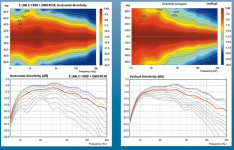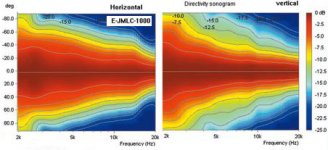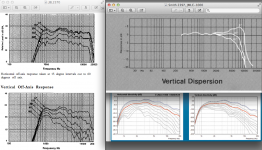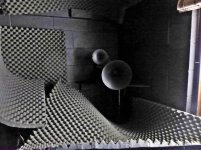Jean-Michel,Iwata-JMLC and E-JMLC horns don't use such kind of diffraction to control directivity. Their directivity in the vertical plane is higher than in the horizontal plane. There is no pattern flip.
Best regards from Paris, France
Jean-Michel Le Cléac'h
The E-JMLC-1000 has higher directivity in the vertical plane in the high frequency range, going to a lower directivity at 1000 Hz (nearly double the beamwidth) than the horn has in the horizontal plane.
In other words, the pattern flips.
Art
Attachments
Hello Art,
I disagree. Such E-Jmlc 1000à is to be used over 2kHz and then you can see that between 2kHz and 3kHza, the horizontal and vertical directivity are the same and then above 3kHz, vertical directivity is higher than horizontal directivity.
Only at the lowest frequency range such horns can be modeled by a planar piston of the dimension of their mouth...
Best regards from Paris, France
Jean-Michel Le Cléac'h
I disagree. Such E-Jmlc 1000à is to be used over 2kHz and then you can see that between 2kHz and 3kHza, the horizontal and vertical directivity are the same and then above 3kHz, vertical directivity is higher than horizontal directivity.
Only at the lowest frequency range such horns can be modeled by a planar piston of the dimension of their mouth...
Best regards from Paris, France
Jean-Michel Le Cléac'h
Attachments
Most of the LeCleac'h horn arrangements I am seeing in reality seem to have bass boxes other than bass horns.
This allows the mid horns to stick out ahead of the bass box to time align, yet have the mouth in free field where it belongs.
Yet, if using a longer bass horn, to time align without electronic delay, the mid horn has to be moved back over the top of the bass horn. I'm wondering what degree of vertical separation between the two horns is the minimal separation that allows the mid horn to be in free field and not affected by the top of the bass horn or other horizontal platform below the mid horn. I assume this is also dependent on the mid horn cutoff frequency, and that an absorptive padding on top of the bass horn would help regarding reflections, but what about the shape of the wave fronts from the mid horn? Low frequencies would not be absorbed that much by padding, and the acoustic load on the mid horn might be affected. Any rules of thumb regarding vertical separation to minimize this problem without resorting to moving mids forward and using electronic delay?
This allows the mid horns to stick out ahead of the bass box to time align, yet have the mouth in free field where it belongs.
Yet, if using a longer bass horn, to time align without electronic delay, the mid horn has to be moved back over the top of the bass horn. I'm wondering what degree of vertical separation between the two horns is the minimal separation that allows the mid horn to be in free field and not affected by the top of the bass horn or other horizontal platform below the mid horn. I assume this is also dependent on the mid horn cutoff frequency, and that an absorptive padding on top of the bass horn would help regarding reflections, but what about the shape of the wave fronts from the mid horn? Low frequencies would not be absorbed that much by padding, and the acoustic load on the mid horn might be affected. Any rules of thumb regarding vertical separation to minimize this problem without resorting to moving mids forward and using electronic delay?
So that is exactly the same phenomenon as any other horn, there is no magic bullet:
you have to keep the crossover high enough to avoid the pattern flip range, which is dictated by the vertical dimension.
Hello Pos,
I disagree again. pattern flip Inside the interval of frequency inside which the horn is used is for sure to be avoid. But in the case of both the Iwata-Le Cléac'h and the e-JMLC there is no pattren flip inside that interval of frequency inside which they are used.
Surely you can see horns having horrible pattern flip (Smith horn...) but this is not the case with both the Iwata-Le Cléac'h and the e-Jmlc as their
directivity is the same as a round horn near their acoustical cut-off frequencies (as predicted by theory) but as soon the ferquency is higher, both horizontal and vertical directivity decreases but with a higher directivity decrease for the horizontal one.
(Both horizontal and vertical directivity of the E-JMLC is somewhat smaller than the directivity of the axisymetrical Le Cleac'h horn of the same cut-off frequency which is a plus for the e-jmlc for people who want a large "sweet spot". The price to pay being just some equalization to be performed...)
Best regards from Paris, France
Jean-Michel Le Cléac'h
Originally Posted by pos
So that is exactly the same phenomenon as any other horn, there is no magic bullet:
you have to keep the crossover high enough to avoid the pattern flip range, which is dictated by the vertical dimension.
Jean-Michel,
I would agree that the pattern flip in the range of frequency you specify the horn to be used is not problematic, but the difference between the "horrible pattern flip" exhibited by the Smith horn and the pattern flip the E-JMLC 1000 polars show is just a matter of degree.
The pattern flip the JBL 2370 bi radial exhibits is similar to the E-JMLC 1000, though the 2370 has a larger vertical height, so the flip occurs at a lower frequency.
The Renkus Heinz complex conic horns have vertical heights similar or equal to the horizontal width, so do not exhibit the pattern flip common to all horns with vertical heights less than the horizontal width.
Any horn requires the vertical height to be a wavelength long to provide pattern control, simple physics determines that your horn with a vertical height of 115mm will begin to have progressively wider dispersion below 2260 Hz as the waves begin to diffract around the mouth.
There is nothing wrong with your horns obeying the laws of physics, but you seem to be disagreeing with those laws .
.
Art
So that is exactly the same phenomenon as any other horn, there is no magic bullet:
you have to keep the crossover high enough to avoid the pattern flip range, which is dictated by the vertical dimension.
Hello Pos,
I disagree again. pattern flip Inside the interval of frequency inside which the horn is used is for sure to be avoid. But in the case of both the Iwata-Le Cléac'h and the e-JMLC there is no pattren flip inside that interval of frequency inside which they are used.
Surely you can see horns having horrible pattern flip (Smith horn...) but this is not the case with both the Iwata-Le Cléac'h and the e-Jmlc as their directivity is the same as a round horn near their acoustical cut-off frequencies (as predicted by theory) but as soon the ferquency is higher, both horizontal and vertical directivity decreases but with a higher directivity decrease for the horizontal one.
Jean-Michel,
I would agree that the pattern flip in the range of frequency you specify the horn to be used is not problematic, but the difference between the "horrible pattern flip" exhibited by the Smith horn and the pattern flip the E-JMLC 1000 polars show is just a matter of degree.
The pattern flip the JBL 2370 bi radial exhibits is similar to the E-JMLC 1000, though the 2370 has a larger vertical height, so the flip occurs at a lower frequency.
The Renkus Heinz complex conic horns have vertical heights similar or equal to the horizontal width, so do not exhibit the pattern flip common to all horns with vertical heights less than the horizontal width.
Any horn requires the vertical height to be a wavelength long to provide pattern control, simple physics determines that your horn with a vertical height of 115mm will begin to have progressively wider dispersion below 2260 Hz as the waves begin to diffract around the mouth.
There is nothing wrong with your horns obeying the laws of physics, but you seem to be disagreeing with those laws
Art
Attachments
Having considered the horn designs, I am much convinced that curvature radius of horn walls should gradually decrease as do the LeCleach type horns. The main consideration of how depend on the driver involved. Considering the directivity characteristics and loading, I am looking at trying out these designs at the extreme ends of speaker spectrum in two way or three way designs. Would appreciate links to any experience in LeCleach based subs and back loading horns.
Are you sure, Soongsc? LF horns must incorporate the floor reflection as part to the design. Maybe the JMLC could be truncated at the 90-degree point where it meets the floor, since there will be another (reflected) JMLC horn right under the floor. Below 100 Hz, the floor will be more than 90% reflective, even with heavy carpeting.
Well, by using corners, you are committing to a folded horn like a Klipschorn (unless you are building them into the room itself). Then the response will be kind of funky from 250 Hz and above, so that implies a crossover to a straight-bass horn or a very large MF horn.
Klipsch cheated by pretty much ignoring the trouble in the 250 Hz to 500 Hz range; check out the unsmoothed response of a KHorn some time. When I was young, I remember seeing an extreme audiophile's system with a KHorn bass section and a very large wood multicell. In retrospect, it must have been a 300 Hz multicell, since it was one of the biggest ones I've ever seen. That's the most elegant solution for good response between the bad region of the KHorn and the LF region of the large-format compression driver.
Klipsch cheated by pretty much ignoring the trouble in the 250 Hz to 500 Hz range; check out the unsmoothed response of a KHorn some time. When I was young, I remember seeing an extreme audiophile's system with a KHorn bass section and a very large wood multicell. In retrospect, it must have been a 300 Hz multicell, since it was one of the biggest ones I've ever seen. That's the most elegant solution for good response between the bad region of the KHorn and the LF region of the large-format compression driver.
I am not sure what the Klipsch horn design accomplishes it goal, but I do not believe in folding horns. With the right kind of folding you can control damping of the driver, but usage of the back wave is not ideal.
The concept of using a horn on the backload would be pretty much like a base reflex except that you use the horn to sort of control how the wave is directed. For example this has been done in the Lullaby where the port is upward intending to excited the mode between the floor and the ceiling. This is not ideal, but for small speakers, there needs to be some design to take advantage of the room. The uncertainty in making this larger and directing it to excite lower modes is something I have not experienced before, so it will be interesting how things work. Of course it would be tricky trying to bring in the horn part below the driver resonance points.
One thing I have tried is using an existing enclosure with a Jordan JX125, and opening the back like an opening door, it was possible to find a point where the organs let me feel the tremble, and that is what I am looking for.
The concept of using a horn on the backload would be pretty much like a base reflex except that you use the horn to sort of control how the wave is directed. For example this has been done in the Lullaby where the port is upward intending to excited the mode between the floor and the ceiling. This is not ideal, but for small speakers, there needs to be some design to take advantage of the room. The uncertainty in making this larger and directing it to excite lower modes is something I have not experienced before, so it will be interesting how things work. Of course it would be tricky trying to bring in the horn part below the driver resonance points.
One thing I have tried is using an existing enclosure with a Jordan JX125, and opening the back like an opening door, it was possible to find a point where the organs let me feel the tremble, and that is what I am looking for.
Hello Art,
Thank you for the graphs that demonstrate that the Smith horn possess more "pattern flip" than the E-JMLC horns (despite what you said).
Doing this is assimilating the horn to an equivalent rigid flat piston. If with truncated horns this is often the case I disagree with that statement when it comes to "quasi-infinite horns" such as the Le Cleac'h horns which naturally have a roll back at their mouth.
Most of the time in horns and loudspeaker design we still use such simplistic physics laws and this is a brake to creativity.
Best regards from Paris, France
Jean-Michel Le Cléac'h
Thank you for the graphs that demonstrate that the Smith horn possess more "pattern flip" than the E-JMLC horns (despite what you said).
Any horn requires the vertical height to be a wavelength long to provide pattern control, There is nothing wrong with your horns obeying the laws of physics, but you seem to be disagreeing with those laws.
Art
Doing this is assimilating the horn to an equivalent rigid flat piston. If with truncated horns this is often the case I disagree with that statement when it comes to "quasi-infinite horns" such as the Le Cleac'h horns which naturally have a roll back at their mouth.
Most of the time in horns and loudspeaker design we still use such simplistic physics laws and this is a brake to creativity.
Best regards from Paris, France
Jean-Michel Le Cléac'h
Last edited:
Most of the LeCleac'h horn arrangements I am seeing in reality seem to have bass boxes other than bass horns.
This allows the mid horns to stick out ahead of the bass box to time align, yet have the mouth in free field where it belongs.
Yet, if using a longer bass horn, to time align without electronic delay, the mid horn has to be moved back over the top of the bass horn. I'm wondering what degree of vertical separation between the two horns is the minimal separation that allows the mid horn to be in free field and not affected by the top of the bass horn or other horizontal platform below the mid horn. I assume this is also dependent on the mid horn cutoff frequency, and that an absorptive padding on top of the bass horn would help regarding reflections, but what about the shape of the wave fronts from the mid horn? Low frequencies would not be absorbed that much by padding, and the acoustic load on the mid horn might be affected. Any rules of thumb regarding vertical separation to minimize this problem without resorting to moving mids forward and using electronic delay?
Bump.
No help here? This seems an importanct question to resolve for integration with bass horn. How much free field is necessary for the mouth?
Bump.
No help here? This seems an importanct question to resolve for integration with bass horn. How much free field is necessary for the mouth?
Hello Pooge,
The proud owners of those bass horns (Le Cléac'h "stand" type bass horn) are not complaining about the sound.
http://www.diyaudio.com/forums/atta...427-jean-michel-lecleach-horns-floor-horn.jpg
http://nsm01.casimages.com/img/2009/05/17//090517055721545253677910.jpg
Best regards from Paris, France
Jean-Michel Le Cléac'h
Hello Pooge,
The proud owners of those bass horns (Le Cléac'h "stand" type bass horn) are not complaining about the sound.
http://www.diyaudio.com/forums/atta...427-jean-michel-lecleach-horns-floor-horn.jpg
http://nsm01.casimages.com/img/2009/05/17//090517055721545253677910.jpg
Best regards from Paris, France
Jean-Michel Le Cléac'h
Thanks for responding. However, I'm not sure you are understanding what I am asking.
Your horn profile mouth is designed to allow a wavefront to expand "naturally" from the mouth, so a baffle is not recommended. However, if such a horn is placed on top of a bass horn (in order to time align), instead of in front of it, there will no longer be a free field in front of the mid horn to expand "naturally". At worst the reflection off the top of the bass horn will alter the acoustic load of the mid horn, but at least cause some diffraction. I'm just wondering as to what amount of minimum vertical spacing is necessary between the top of the bass cabinet and the mouth of the mid horn to make this issue sonically irrelevant.
In the pictures you show, the mids are placed in "free field", so they don't address my question.
Thanks.
Thanks for responding. However, I'm not sure you are understanding what I am asking.
Your horn profile mouth is designed to allow a wavefront to expand "naturally" from the mouth, so a baffle is not recommended. However, if such a horn is placed on top of a bass horn (in order to time align), instead of in front of it, there will no longer be a free field in front of the mid horn to expand "naturally". At worst the reflection off the top of the bass horn will alter the acoustic load of the mid horn, but at least cause some diffraction. I'm just wondering as to what amount of minimum vertical spacing is necessary between the top of the bass cabinet and the mouth of the mid horn to make this issue sonically irrelevant.
In the pictures you show, the mids are placed in "free field", so they don't address my question.
Thanks.
Hello Pooge, that is a question yet answered many times...
There is different ways to avoid such diffraction, one is to have some distance between the horn and the bass enclosure. Even if few peoples argue that theorically this will make a loss of coherence of the wavefront and such system will have to be used at a minimum 6 m distance, experience prove that this is simply not true...
Here is an example :
http://www.studiopressdigital.fr/prestige/moteur/uploads/img4acef6a4d812a.jpg
Best regards from Paris, France
Jean-Michel Le Cléac'h
If all these systems were perfect, they would sound pretty much the same. However, I am sure in practice these will all sound different. These audible differences are what effect design trade off. I think Pooge is trying to get a feeling what the trade offs are in terms of listening.
Hello Art,
Thank you for the graphs that demonstrate that the Smith horn possess more "pattern flip" than the E-JMLC horns (despite what you said).
Jean-Michel, I don't think anyone said that. Of course your horn will have "less pattern flip", ie control vertical directivity lower than a smith horn (which is something like 5cm high, and uses almost only diffraction in the vertical plan...), but this is not much more than a pure geometrical problem and any horn with similar dimensions to yours will have the same vertical directivity "cutoff".
There is nothing wrong about it: "pattern flip" is just the symptom of a horn used lower than its "vertical cutoff" (lets call it that way...). Some system actually put this symptom to good use, like the JBL Array 1400 for example with a *very* smooth woofer/horn directivity transition.
Last edited:
- Home
- Loudspeakers
- Multi-Way
- Jean Michel on LeCleac'h horns



